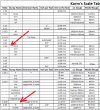Sorry, I had a moment of mischievous boredom last.
Most people who know me would have told me to shut up and ........, well just behave.
But it does go to reinforce the point that G Scale is not a scale and is wrongly referenced.
My models are 1:22.5 scale, or their abouts, all except for one just now are narrow gauge, so talking about them here is acceptable, i have one model which although it's the same scale because it's based on a standard gauge prototype I told this isn't the place to discuss it, so should I feel put out that only my narrow gauge trams should be mentioned here.
Then we have a live steam loco, and coaches yet to be finished which are 7/8" scale running on 45mm gauge track which seem to me acceptable, which goes to demonstrate that its not just 1:22.5 scale narrow gauge that is acceptable to discuss here but anything which runs on 45mm gauge track.
Yes I am being awkward and other things in the readers mind, but I'm right, oh, and I am letting myself be distracted from household chores, so don't take this thread too serious, but I am right, and I do find it extremely frustrating that a modelling size referred to as a scale has absolutely he haw to do with scale.
Another question on the topic which is relevant though.
I am and will be running bachman trams which I believe are intended to represent 1:22.5 scale, Manx Electric Railway trams which are a 3ft prototype and I have scaled for operation on 45mm gauge track, and some Hong Kong trams in the list to build (if I survive this thread) which are a 3ft 6in prototype and will be built to scale to run on 45mm gauge track. Ignoring the Groudle Glen stock which doesn't utilise overhead wires.
Taking the prototypes difference of scale in to consideration, what overhead wire height should I adopt for the garden line and indoor layout, thoughts?
Another wee thing, when the indoor layout is finished it is planned to take it to exhibitions, what scale should I say the

